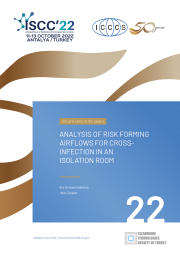ANALYSIS OF RISK FORMING AIRFLOWS FOR CROSS-INFECTION IN AN ISOLATION ROOM
Authors:
Ilse Schoenmakers , Wim ZeilerKeywords:
Isolation Room, Cross-infection, Value of Air Changes HourAbstract:
Hospitals, need a lot of energy for their Heating Ventilation and Air Conditioning therefore it is important to look at possibilities to reduce the energy use. However, this of course has to be done without endangering the primary functions related to the patient’s and staff safety. The HVAC energy consumption in isolation rooms is mainly caused by large volumes of air supply and are continuous supplying to the rooms, regardless the occupancy of the room. Resulting in over conditioned rooms, which leads to excessive energy consumption. It is concluded that the actual energy supply must be aligned to the energy demand. Solutions frequently used for this problem is HVAC setback using time schedules based on occupancy profiles. HVAC set back in isolation rooms require an unconventional approach, others than time schedules. A possible solution is manual HVAC setback for heating, cooling and ventilation. However, an important note to manual HVAC setback in ventilation rate is the increased risk of disease transmission through human failure. The risk of HVAC setback for heating and cooling is expected to be low. This research focusses on the amount of HVAC set back. The manner of setback is not investigated. The amount of HVAC setbackdepends on the type of occupancy in the room. For non-airborne infectious patients, a reduction of ACH to the guidance for single bedrooms (100 m3/h per person = 2 ACH) is possible, provided that the comfort requirements are reached with these requirements. The ACH for isolation type of patients is doubtful. For not occupied rooms, the ACH need to be sufficient to maintain the space conditions for the time a patient need to be hospitalized. But also to keep the room at a low positive pressure in order to keep contaminants outside the room. According to the room model results it is concluded that the ACH for isolation patients can be reduced to < 6 ACH, however a more detailed model is needed which provides more certainty. The room model as defined in this research revealed that
transmission of infectious particles through undefined cracks and gaps is most crucial (has most influences on transmission). Additionally, it is concluded that at low ACH the contamination concentrations are higher, however, more evenly distributed.
Article:
 Click to Download PDF
Click to Download PDF
